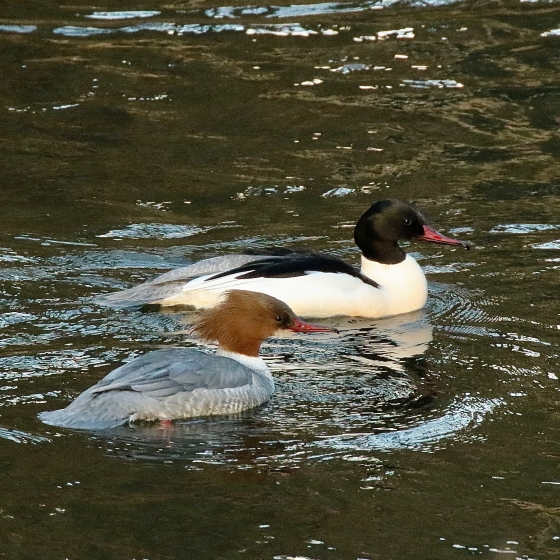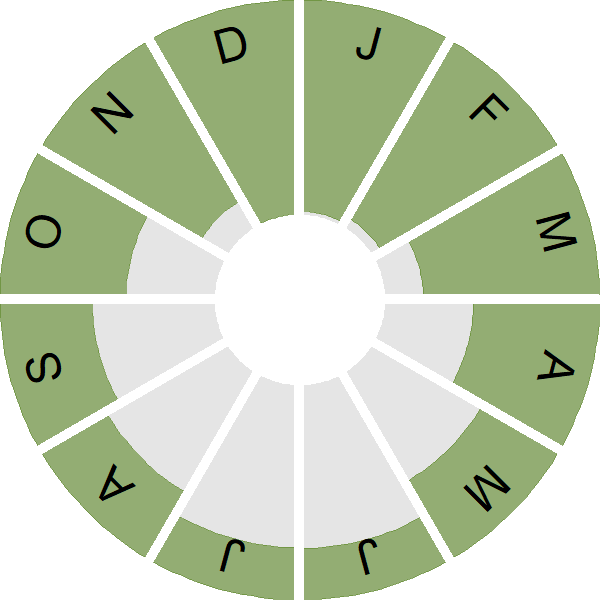Goosander

Introduction
Females and juveniles have a gingery-orange head and grey body, the two sharply delineated, males a glossy green head, blood-red beak, black on the wings and back contrasting with a white body, tinged salmon-pink in the breeding season.
First colonising Scotland in c.1871, Goosanders have dramatically increased in numbers and range, occupying most river catchments in Scotland, Wales and Northern England.
Goosanders are generally found diving for fish and aquatic invertebrates on rivers and lochs, with females moving downstream to estuaries and the coast with ducklings once they have hatched. Goosanders nests in tree cavities and have used larger nest boxes.
- Our Trends Explorer gives you the latest insight into how this species' population is changing.

Key Stats
Identification
ID Videos
This section features BTO training videos headlining this species, or featuring it as a potential confusion species.
Goosander and Red-breasted Merganser
Songs and Calls
Call:
Status and Trends
Conservation Status
Population Change
Goosanders were first discovered to have colonised the UK in Perthshire in 1871, and spread from Scotland into northern England in the 1940s (Holloway 1996). Between the first two breeding atlases, the species expanded its range in northern England, and colonised Wales and southwest England. WBS samples became large enough for annual monitoring in 1980, and show sustained population increase, apart from a slight dip in the late 1990s. The BTO's two national surveys of sawbills demonstrated an average increase in population size of 3% per annum between 1987 and 1997 (Rehfisch et al. 1999). There has been considerable further range expansion since 1990 (Balmer et al. 2013). Reasons for the colonisation of the UK, and the subsequent range expansion and population increase, are unknown. The species' winter trend in Britain, comprising British breeders and continental visitors, rose steeply from the late 1960s and peaked in the mid 1990s, before falling back, and now stands at early 1990s levels (WeBS: Frost et al. 2020).
Distribution
Goosanders breed throughout Scotland, northern England, south to Derbyshire, Wales, the Marches and Devon. In winter, they occupy rivers and a wide range of freshwater bodies throughout Britain, as well as some western and northern estuaries. They are largely absent from upland areas in northern Scotland and from parts of southern and eastern England.
Occupied 10-km squares in UK
or view it on Bird Atlas Mapstore.
or view it on Bird Atlas Mapstore.
European Distribution Map
Distribution Change
The winter range of the Goosander has increased by 87% since the 1981–84 Winter Atlas. Gains are apparent throughout and are particularly noticeable in Ireland, Wales and central and southern England.
Change in occupied 10-km squares in the UK
or view it on Bird Atlas Mapstore.
or view it on Bird Atlas Mapstore.
Seasonality
Goosanders are present year-round, with higher reporting in winter when they can be seen at large waterbodies.
Weekly pattern of occurrence
The graph shows when the species is present in the UK, with taller bars indicating a higher likelihood of encountering the species in appropriate regions and habitats.

Movement
Britain & Ireland movement
Foreign locations of birds ringed or recovered in Britain & Ireland
Dots show the foreign destinations of birds ringed in Britain & Ireland, and the origins of birds ringed overseas that were subsequently recaptured, resighted or found dead in Britain & Ireland. Dot colours indicate the time of year that the species was present at the location.
- Winter (Nov-Feb)
- Spring (Mar-Apr)
- Summer (May-Jul)
- Autumn (Aug-Oct)

European movements
EuroBirdPortal uses birdwatcher's records, such as those logged in BirdTrack to map the flows of birds as they arrive and depart Europe. See maps for this species here.
The Eurasian-African Migration Atlas shows movements of individual birds ringed or recovered in Europe. See maps for this species here.
Biology
Productivity and Nesting
Nesting timing
Egg measurements
Clutch Size
Survival and Longevity
Survival is shown as the proportion of birds surviving from one year to the next and is derived from bird ringing data. It can also be used to estimate how long birds typically live.
View number ringed each year in the Online Ringing Report.
lifespan
Survival of adults
Biometrics
Wing length and body weights are from live birds (source).
Ring Size
Classification, names and codes
Classification and Codes
- Order: Anseriformes
- Family: Anatidae
- Scientific name: Mergus merganser
- Authority: Linnaeus, 1758
- BTO 2-letter code: GD
- BTO 5-letter code: GOOSA
- Euring code number: 2230
Alternate species names
- Catalan: bec de serra gros
- Czech: morcák velký
- Danish: Stor Skallesluger
- Dutch: Grote Zaagbek
- Estonian: jääkoskel
- Finnish: isokoskelo
- French: Grand Harle
- Gaelic: Sìolta
- German: Gänsesäger
- Hungarian: nagy bukó
- Icelandic: Gulönd
- Irish: Síolta Mhór
- Italian: Smergo maggiore
- Latvian: liela gaura
- Lithuanian: didysis danciasnapis
- Norwegian: Laksand
- Polish: nuroges
- Portuguese: merganso-grande
- Slovak: potápac velký
- Slovenian: veliki žagar
- Spanish: Serreta grande
- Swedish: storskrake
- Welsh: Hwyaden Ddanheddog
Research
Causes of Change and Solutions
Causes of change
There is little good evidence available regarding the drivers of the breeding population increase in this species in the UK.
Further information on causes of change
No further information is available.
Information about conservation actions
Goosander is currently increasing both its population and its range in the UK and hence specific conservation action is not currently required. The species breeds along rivers so the continuation of policies to maintain and improve water quality are likely to benefit this species. It is a hole nesting species and provision of nest boxes may therefore also help support the Goosander.
Conflict with anglers may become a problem should the population continue to increase. Therefore, appropriate discussions with anglers and other stakeholders may be required in the future to ensure policies are in place which ensure the ongoing conservation of the species.
Publications (1)
Abundance, distribution and habitat use of Goosanders Mergus merganser and Red-breasted Mergansers Mergus serrator on British rivers
Author: Gregory, R.D., Carter, S.P. & Baillie, S.R.
Published: 1997
01.01.97
Papers

